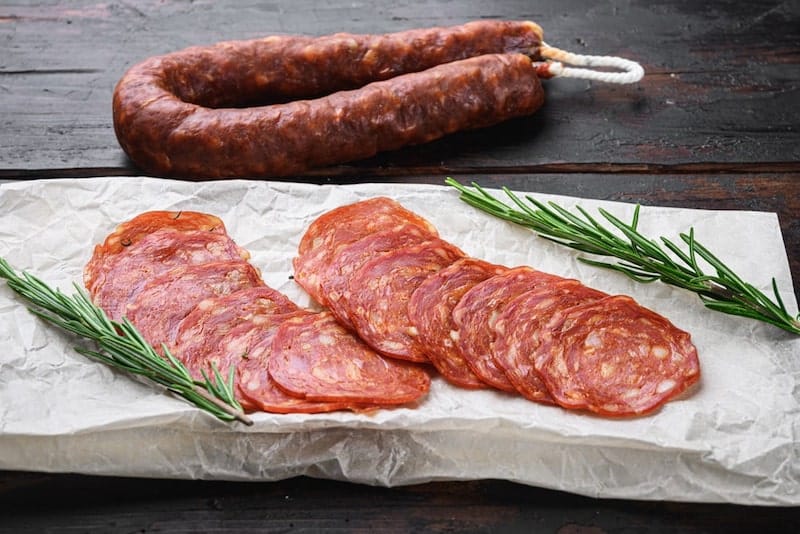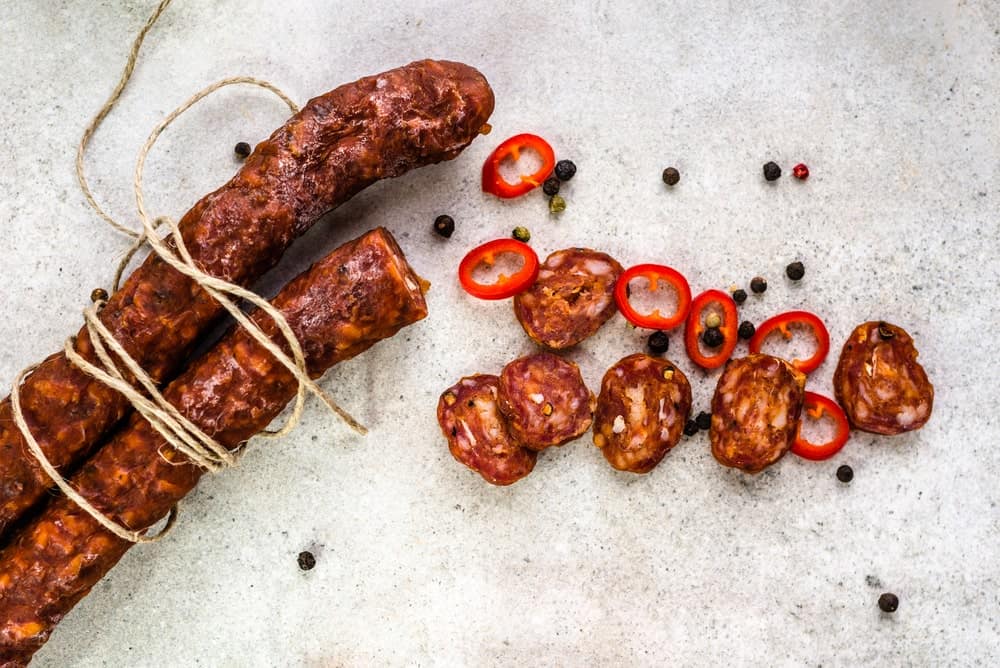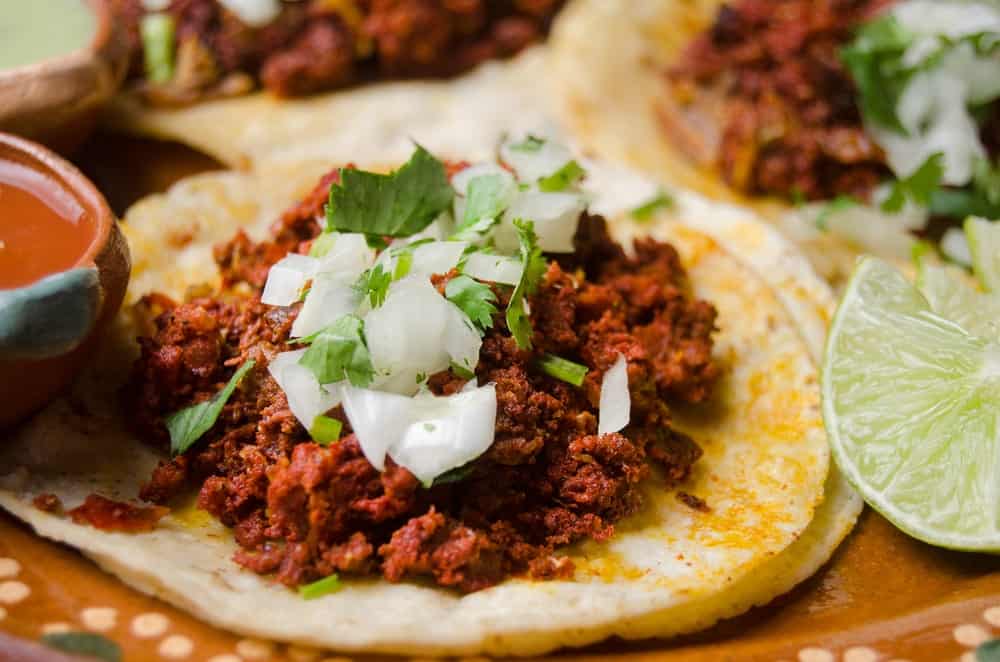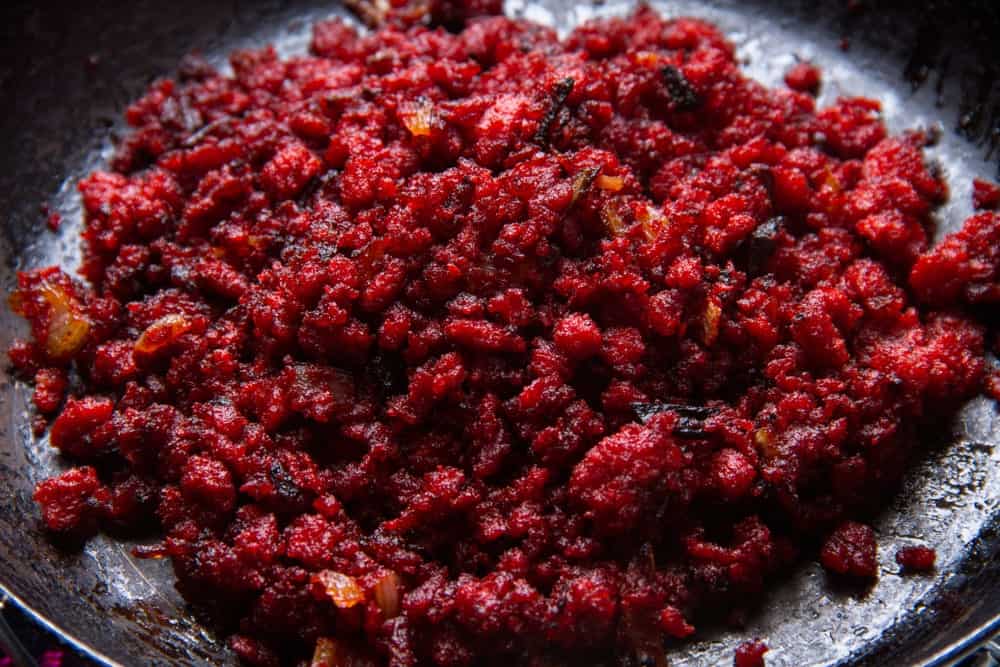Can Chorizo Be Eaten Raw?
There are so many different types of chorizo out there. When you get it from the store, depending on the kind you buy, you either have to cook it or you can eat it as is, straight out of the package.
So, can chorizo be eaten raw? The short answer is: It depends on the variety.
- Spanish Chorizo: This type is typically cured or smoked and can be eaten without cooking, much like salami or other dried sausages. When you slice it, it’s usually firm and has a strong, spicy flavor. This type of chorizo is often used in tapas dishes in Spain.
- Mexican Chorizo: This chorizo is a fresh sausage, made primarily from ground pork, chilies, and spices. It is usually sold in a casing and is raw, requiring thorough cooking before consumption. Raw Mexican chorizo can have a crumbly texture and needs to be fully cooked to be safe to eat, as consuming it raw poses the same risks as eating any other raw meats, such as bacterial contamination.
Here I’ll discuss the different types of chorizo and how they’re made and consumed, to help you understand which chorizo you can eat without cooking it.

What is Chorizo?
Chorizo is a pork sausage that originated in the Iberian Peninsula. Depending on the region, the flavor and preparation method can vary significantly.
However, the dominant aroma almost always comes from a type of pepper.
The Spanish paprika gives chorizo a vivid, reddish hue, along with a spicy kick.
The sausage is wrapped in natural intestine casings, but some artificial casings also do the trick.
Chorizo is made from pork or beef, but there are also chicken or turkey varieties. In some parts of the world, the mixture can even include exotic meats like iguana or ostrich.
Typically, the sausage comes in two varieties: raw chorizo, which requires further preparation, and fully cured, dry chorizo, which can be eaten straight away.
Types of Chorizo
Spanish Chorizo
Spanish chorizo is considered the most authentic, made with pork and seasoned with a blend of smoked paprika, spices, garlic, and white wine.
The meat mixture is packed into natural or synthetic casings and shaped into links that vary in size.
Spanish chorizo is cured and thoroughly smoked, which helps protect the meat while also adding the signature flavor. After that, the sausage is air-cured for several weeks, if not months.
If you’ve ever eaten in a Spanish bodega, you’ve probably come across this delicious dry-cured sausage.
Besides being a popular finger food, chorizo is also an ingredient in many traditional Spanish dishes, including the famous paella.

Mexican Chorizo
Mexican chorizo is sold raw, meaning you need to cook it before consumption. Also, before adding it to your dish, make sure not to remove the skin since it’ll be easier to prepare.
Almost all Mexican chorizo is made with freshly ground, raw pork.
Traditionally, the meat is infused with additional pork fat and various herbs, spices, chili peppers (for flavor and color), and vinegar.
The final product is usually packed into short links and air-dried for a few days.
Chorizo is typically used in limited amounts to enhance the taste of unique Mexican dishes such as frittatas and tacos.

Portuguese Chorizo
Another variety is the Portuguese chourico, although it’s not as widespread in the United States. It’s somewhat similar to Spanish chorizo, with a few notable distinctions.
Compared to other chorizo sausages, chourico has a more pungent smoked taste due to the unique cooking process.
Furthermore, the seasoning ratios are drastically different. In contrast to other varieties, paprika isn’t the dominant spice in the blend.
The pepper reduction gives chourico a distinct taste, made unique by adding a shot of Portuguese red wine to the mix. As a result, the sausage has a rather dark red, almost orange hue.
As mentioned, chourico is relatively uncommon in the U.S. However, you can find it in counties with a strong Portuguese community, such as Rhode Island and southeastern Massachusetts.
Nonetheless, it’s a welcome addition to the chorizo family due to its distinct flavor profile.
Can Chorizo Be Eaten Raw?
The typical Spanish chorizo is either fermented, smoked, or cured, so all you have to do is slice it up and start munching.
Chourico can also be eaten raw, although it’s not as common. This Portuguese sausage is typically cut into slices and flame-cooked with aguardiente in a unique earthen pot.
Mexican chorizo is the only variety that’s sold raw, and therefore needs to be cooked before consumption. Since the meat is mostly pork, there’s a danger of contracting a bacteria or parasite if eaten raw.

But how can you tell if the chorizo you bought is pre-cooked? Luckily, there are several tell-tale signs.
First, the density of the sausage is a great way to know whether it’s been pre-cooked or cured. If you can slice it without it breaking apart, feel free to take a bite. In other words, if the texture is rough and dry, it’s a sign of curing.
You can also look at the package. If there are cooking instructions written on the back, it’s not meant to be eaten raw.
Also, think about where it’s placed in the supermarket. If you found it in the cheese or deli section, it’s probably good to go.
On the other hand, if it was kept in a refrigerator, you’ll have to cook it first.
How to Cook Chorizo
So, what’s the best way to cook raw chorizo? Again, it depends on the variety. Overall, the spicy sausage is a pretty versatile ingredient, so don’t be afraid to experiment.
There are a few general tips for making a mean chorizo dish. Since fresh chorizo is naturally greasy, you don’t have to add oil when cooking. Any extra fat can be poured out used for other purposes.
To keep the slices from sticking to the pan, add a little water. Adding water isn’t needed if you’re cooking ground Mexican chorizo.
Since it’s all ground pork, you’ll know it’s ready when it starts to tan. Stir continuously to avoid burning, and then remove the fat.
It’s generally not advised to substitute Mexican chorizo for Spanish chorizo in a particular recipe. And, of course, the same goes for recipes that expressly require Mexican chorizo.
Because of the cooking process, these two kinds have different flavor profiles.
What is the Shelf Life of Chorizo?
If stored in the refrigerator, chorizo can last for a couple of weeks. But is it possible to prolong its shelf life?
The answer is yes – you should just move it to the freezer instead. Chorizo that’s been frozen can keep its consistency for up to ten months. It’ll still be safe to eat, although it might not taste as good.
Chorizo Dishes You Can Prepare
Tapas
You can use either Spanish or Mexican chorizo for this delicious appetizer. The Spanish sausage can be consumed raw, so slice it and arrange it on the plate.
If you’re going for a more Tex-Mex flavor, make sure to fry the chorizo before cutting it. You can also pre-roast some chorizo in the oven for a charred earthy finish and a more gourmet experience.
Breakfast
Although chorizo isn’t exactly nutritious, it sure makes for a filling breakfast. Mexican chorizo, sauteed without its wrapper, makes an excellent topping that works well with potatoes and eggs.
Soup
Try making chorizo soup for a hearty dinner. A thick spicy soup made with chopped chorizo and fresh vegetables is as delicious as it is filling.
Pro tip: if you’re using fresh chorizo, sauté them separately to cut down on grease.
In Summary
So, can chorizo be eaten raw? The meat is sold in two varieties: raw Mexican sausage and fermented cured sausage, similar to salami or pepperoni.
Since the latter is pre-cooked, it’s safe to eat it right off the bat. However, sometimes manufacturers forget to point out if the chorizo is fully cured or sold raw.
One thing to remember is that raw meats of any type are generally mushy and soft after being removed from the packaging.
In contrast, cured chorizo has a hard texture that doesn’t change its shape. If you can’t tell from the packaging, cook it for 5-10 minutes. It’s better to be safe than sorry.






